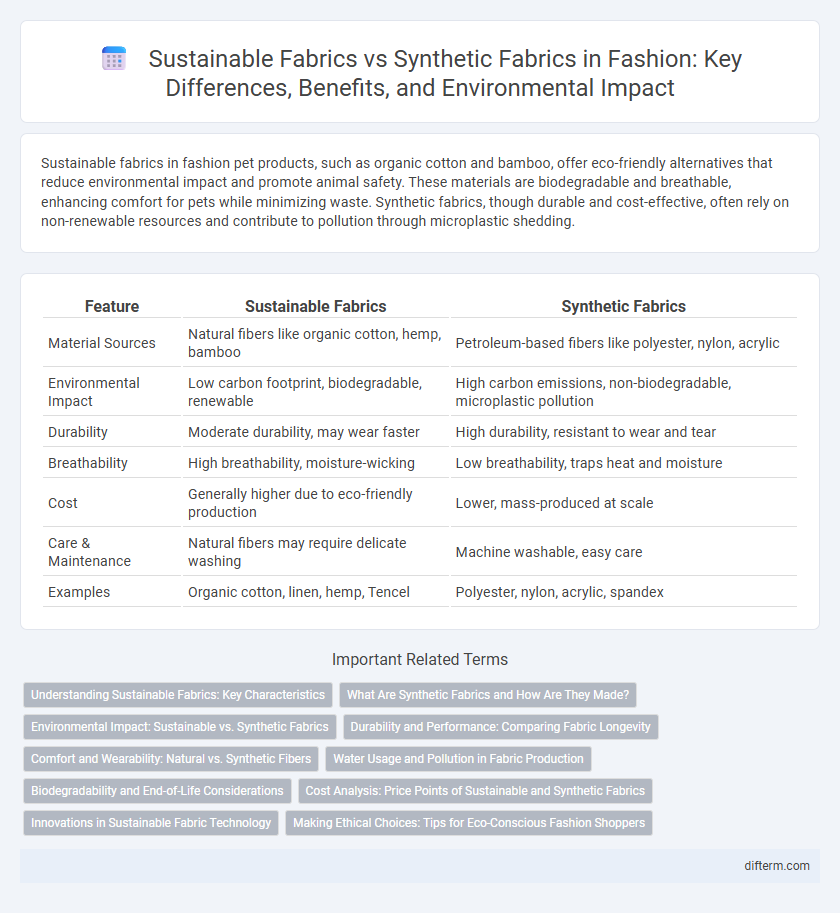Sustainable fabrics in fashion pet products, such as organic cotton and bamboo, offer eco-friendly alternatives that reduce environmental impact and promote animal safety. These materials are biodegradable and breathable, enhancing comfort for pets while minimizing waste. Synthetic fabrics, though durable and cost-effective, often rely on non-renewable resources and contribute to pollution through microplastic shedding.
Table of Comparison
| Feature | Sustainable Fabrics | Synthetic Fabrics |
|---|---|---|
| Material Sources | Natural fibers like organic cotton, hemp, bamboo | Petroleum-based fibers like polyester, nylon, acrylic |
| Environmental Impact | Low carbon footprint, biodegradable, renewable | High carbon emissions, non-biodegradable, microplastic pollution |
| Durability | Moderate durability, may wear faster | High durability, resistant to wear and tear |
| Breathability | High breathability, moisture-wicking | Low breathability, traps heat and moisture |
| Cost | Generally higher due to eco-friendly production | Lower, mass-produced at scale |
| Care & Maintenance | Natural fibers may require delicate washing | Machine washable, easy care |
| Examples | Organic cotton, linen, hemp, Tencel | Polyester, nylon, acrylic, spandex |
Understanding Sustainable Fabrics: Key Characteristics
Sustainable fabrics prioritize eco-friendly production methods, utilizing materials such as organic cotton, hemp, bamboo, and recycled fibers that reduce environmental impact and promote biodegradability. These fabrics often feature superior breathability, durability, and low chemical usage compared to synthetic fabrics like polyester and nylon, which rely on petrochemicals and contribute to microplastic pollution. Understanding the lifecycle, resource consumption, and recyclability of sustainable textiles is crucial for making environmentally responsible fashion choices.
What Are Synthetic Fabrics and How Are They Made?
Synthetic fabrics are man-made textiles produced from chemical compounds, primarily derived from petroleum-based polymers such as polyester, nylon, and acrylic. The manufacturing process involves polymerization, where monomers are chemically bonded to create long molecular chains, followed by spinning these polymers into fibers through extrusion or melt spinning techniques. These fabrics are engineered for durability and moisture resistance but pose environmental concerns due to their non-biodegradable nature and reliance on fossil fuels.
Environmental Impact: Sustainable vs. Synthetic Fabrics
Sustainable fabrics like organic cotton, hemp, and bamboo reduce environmental impact by using fewer pesticides, less water, and renewable resources, minimizing pollution and improving soil health. Synthetic fabrics such as polyester and nylon contribute to microplastic pollution and rely heavily on fossil fuels, increasing carbon emissions and environmental degradation. Choosing sustainable fabrics supports circular fashion by promoting biodegradability and reducing landfill waste compared to the non-biodegradable nature of most synthetic textiles.
Durability and Performance: Comparing Fabric Longevity
Sustainable fabrics such as organic cotton, hemp, and bamboo often exhibit enhanced durability due to natural fiber strength and slower wear over time compared to synthetic fabrics like polyester and nylon, which can degrade with repeated washing and exposure to heat. Performance-wise, synthetic fabrics excel in moisture-wicking, elasticity, and resistance to abrasion, making them popular in activewear, whereas sustainable fabrics prioritize breathability and biodegradability without compromising structural integrity. Long-term fabric longevity depends on the specific use case, with sustainable fabrics offering environmental benefits alongside lasting durability, while synthetics provide high-performance features suited for intensive wear.
Comfort and Wearability: Natural vs. Synthetic Fibers
Natural fibers such as organic cotton, linen, and hemp offer superior breathability and moisture-wicking properties, enhancing overall comfort during wear. Synthetic fabrics like polyester and nylon often trap heat and moisture, leading to reduced comfort, especially in warm or active conditions. Wearability of natural fibers also benefits from their softness and hypoallergenic qualities, making them ideal for sensitive skin compared to the potential irritation caused by some synthetic materials.
Water Usage and Pollution in Fabric Production
Sustainable fabrics such as organic cotton and hemp use significantly less water compared to synthetic fabrics like polyester, which require intensive water during production and dyeing processes. Synthetic fabrics contribute to water pollution through the release of microplastics and toxic chemicals into waterways, posing severe environmental hazards. Choosing sustainable fabrics reduces water consumption and minimizes pollutant discharge, supporting healthier ecosystems and responsible fashion practices.
Biodegradability and End-of-Life Considerations
Sustainable fabrics such as organic cotton, hemp, and Tencel are naturally biodegradable, breaking down safely in soil within months to a few years without releasing harmful microplastics. In contrast, synthetic fabrics like polyester and nylon can take over 200 years to decompose, contributing significantly to microplastic pollution in oceans and landfills. End-of-life management for sustainable textiles often involves composting or recycling, whereas synthetic textiles require specialized processes to mitigate environmental impact, highlighting the critical need for circular fashion practices.
Cost Analysis: Price Points of Sustainable and Synthetic Fabrics
Sustainable fabrics such as organic cotton, hemp, and Tencel typically have higher price points compared to synthetic fabrics like polyester and nylon due to their eco-friendly production processes and limited supply chains. Synthetic fabrics benefit from mass production and lower raw material costs, making them more affordable for large-scale manufacturing. However, long-term cost analysis reveals that sustainable fabrics may offer better value by reducing environmental impact and potential regulatory expenses linked to synthetic material pollution.
Innovations in Sustainable Fabric Technology
Innovations in sustainable fabric technology have led to the development of eco-friendly materials such as mushroom leather, biodegradable fibers, and recycled ocean plastics, reducing reliance on conventional synthetic fabrics like polyester and nylon. These advancements enhance durability, breathability, and biodegradability while minimizing environmental impact and water consumption. Brands are increasingly investing in bio-based textiles and closed-loop recycling systems to create sustainable fashion solutions that address pollution and resource depletion.
Making Ethical Choices: Tips for Eco-Conscious Fashion Shoppers
Choosing sustainable fabrics such as organic cotton, hemp, and bamboo reduces environmental impact by minimizing water usage and chemical pollution compared to synthetic fabrics like polyester and nylon derived from fossil fuels. Eco-conscious fashion shoppers should prioritize certifications like GOTS (Global Organic Textile Standard) and OEKO-TEX to ensure ethical sourcing and safer production processes. Incorporating recycled materials or natural fibers into wardrobes supports circular fashion and lowers carbon footprints while promoting biodiversity preservation.
sustainable fabrics vs synthetic fabrics Infographic

 difterm.com
difterm.com